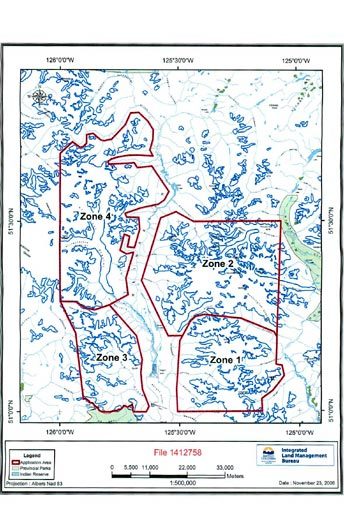In November, Knight Inlet Heli Sports Ltd. (KIH) applied for a heli-skiing permit that would give commercial tenure to four large chunks of southwestern British Columbia, one of which includes Mt. Waddington (13,177′), the Coast Range’s tallest peak. The application is still under review. Although the area is already accessible by helicopter, a service that most alpinists use to approach the range, a number of climbers have voiced concerns about a heli-skiing company operating around Mt. Waddington.

This map illustrates the four zones (over 350,000 hectares) that Knight Inlet Heli Sports Ltd. would service with commercial recreation, including heli-skiing and snowmobiling, pending approval from British Columbia?s Integrated Land Management Bureau. Many climbers are concerned that the new access would diminish the remote experience currently offered by the Coast Range, particularly around Mt. Waddington (13,177?). [Map] Courtesy of www2.lwbc.bc.ca
KIH plans to base its clients on a yacht in Knight Inlet, south of the four proposed skiing areas (two west and two east of Klinaklini River). The section affecting those climbing and ski touring most would be Zone 2, which includes a large portion of the Waddington Range. KIH is also vying for access to other public territory in the Silverthrone-Klinaklini, Whitemantle and Sims-Tumult areas. Some consider the application a “land grab,” as Zone 4’s size alone is upwards of 4,000 square kilometers–an unmanageable expanse for a heli-ski operation without fuel caches, which KIH cedes will not be positioned on public land.
Many backcountry travelers’ affinity for the Coast Range, and in particular the area around Waddington, is its remoteness. The proposed permit includes a clause for “commercial recreation,” which would allow the use of snowmobiles. Some climbers are concerned that commercial, recreational access will turn the area into a noisy playground. Don Serl argues on cascadeclimbers.com that “once the chopper leaves you on your glacier [to climb], the silence returns, and the wilderness experience sets in. That’s not true for heli-skiing, in which the power and ‘rush’ of the helicopter is an integral part of the ‘thrill.'”
Some note that the potential heli-skiing and snowmobiling season does not overlap much with climbing season, which usually picks up in late May. However, others respond that those on ski tours and early season climbs would be disrupted, since another clause in the application states that the commercial operations will steer clear of other land-users by one kilometer. The buffer distance is insignificant, opponents claim, considering the land sizes applied for. The total area in question is over 350,000 hectares.
“Ski-mountaineers and climbers live IN the mountains, absorbing and dealing with the wilderness,” Serl said. “Heli-skiers athleticize ON them, then flit back to civilization. These are diametrically different mind-sets, and I want to see them physically separated too, at least in the Waddington Range.” He also admits that “unless we have LOTS of backcountry use going on, others have a perfectly valid argument that ‘their’ rights trump [backcountry users’]. That’s how most of the Whistler corridor (and other areas too) has been lost as touring terrain to snowmobilers.”
You can read more sides of the debate, and find information to contact British Columbia’s Ministry of Tourism, at www.cascadeclimbers.com.